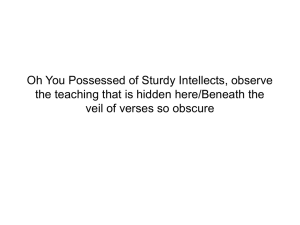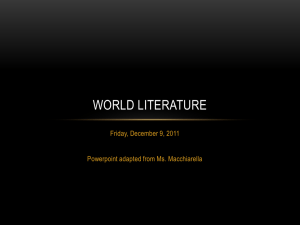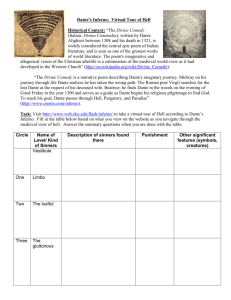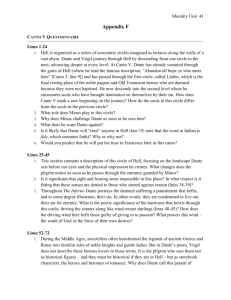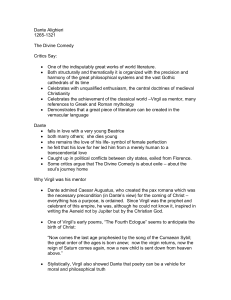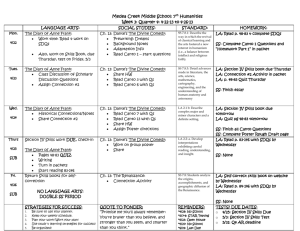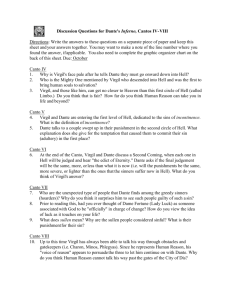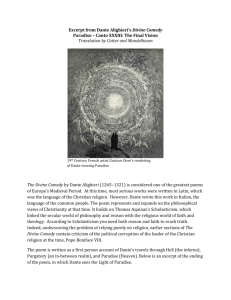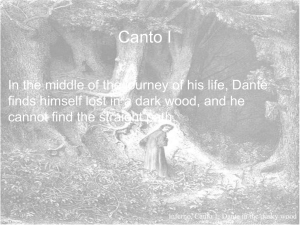Dante Teacher Guide_proofed by Jen Final.indd
advertisement
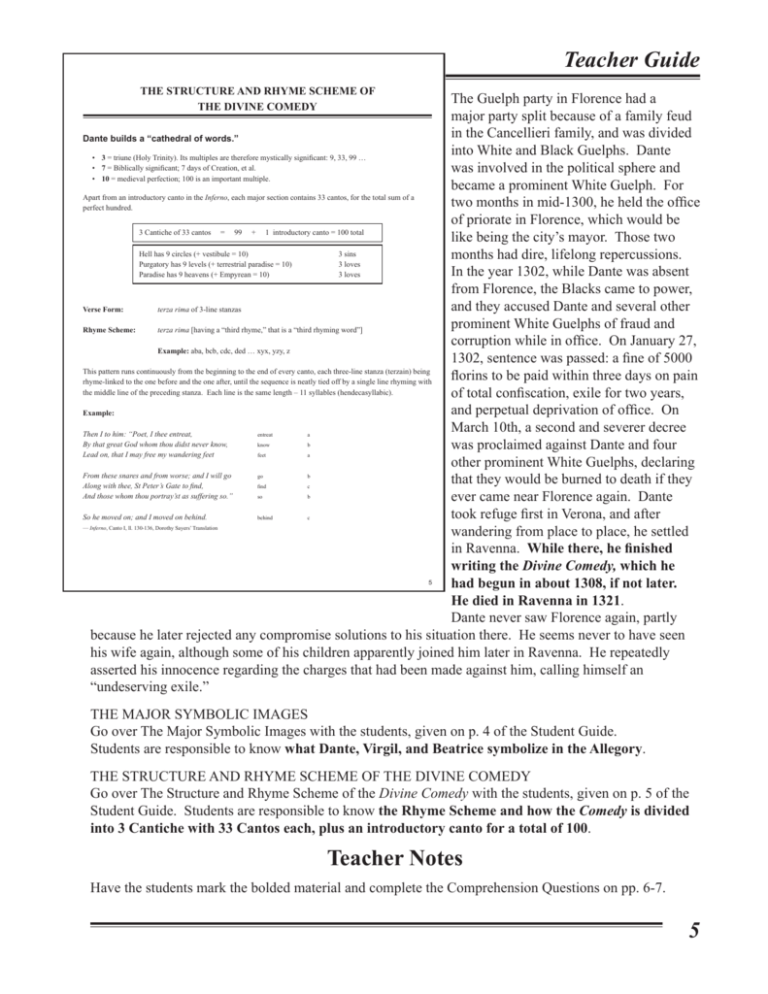
Teacher Guide THE STRUCTURE AND RHYME SCHEME OF THE DIVINE COMEDY The Guelph party in Florence had a major party split because of a family feud in the Cancellieri family, and was divided Dante builds a “cathedral of words.” into White and Black Guelphs. Dante • 3 = triune (Holy Trinity). Its multiples are therefore mystically significant: 9, 33, 99 … • 7 = Biblically significant; 7 days of Creation, et al. was involved in the political sphere and • 10 = medieval perfection; 100 is an important multiple. became a prominent White Guelph. For Apart from an introductory canto in the Inferno, each major section contains 33 cantos, for the total sum of a twomonthsinmid-1300,heheldtheoffice perfect hundred. of priorate in Florence, which would be 3 Cantiche of 33 cantos = 99 + 1 introductory canto = 100 total like being the city’s mayor. Those two Hell has 9 circles (+ vestibule = 10) 3 sins months had dire, lifelong repercussions. Purgatory has 9 levels (+ terrestrial paradise = 10) 3 loves In the year 1302, while Dante was absent Paradise has 9 heavens (+ Empyrean = 10) 3 loves from Florence, the Blacks came to power, and they accused Dante and several other Verse Form: terza rima of 3-line stanzas prominent White Guelphs of fraud and Rhyme Scheme: terza rima [having a “third rhyme,” that is a “third rhyming word”] corruptionwhileinoffice.OnJanuary27, Example: aba, bcb, cdc, ded … xyx, yzy, z 1302,sentencewaspassed:afineof5000 This pattern runs continuously from the beginning to the end of every canto, each three-line stanza (terzain) being florinstobepaidwithinthreedaysonpain rhyme-linked to the one before and the one after, until the sequence is neatly tied off by a single line rhyming with the middle line of the preceding stanza. Each line is the same length – 11 syllables (hendecasyllabic). oftotalconfiscation,exilefortwoyears, andperpetualdeprivationofoffice.On Example: March 10th, a second and severer decree Then I to him: “Poet, I thee entreat, By that great God whom thou didst never know, was proclaimed against Dante and four Lead on, that I may free my wandering feet other prominent White Guelphs, declaring From these snares and from worse; and I will go that they would be burned to death if they Along with thee, St Peter’s Gate to find, And those whom thou portray’st as suffering so.” ever came near Florence again. Dante tookrefugefirstinVerona,andafter So he moved on; and I moved on behind. wandering from place to place, he settled in Ravenna. While there, he finished writing the Divine Comedy, which he 5 had begun in about 1308, if not later. He died in Ravenna in 1321. Dante never saw Florence again, partly because he later rejected any compromise solutions to his situation there. He seems never to have seen his wife again, although some of his children apparently joined him later in Ravenna. He repeatedly asserted his innocence regarding the charges that had been made against him, calling himself an “undeservingexile.” entreat a know b feet a go b find c so b behind c –– Inferno, Canto I, ll. 130-136, Dorothy Sayers’ Translation THEMAJORSYMBOLICIMAGES Go over The Major Symbolic Images with the students, given on p. 4 of the Student Guide. Students are responsible to know what Dante, Virgil, and Beatrice symbolize in the Allegory. THESTRUCTUREANDRHYMESCHEMEOFTHEDIVINECOMEDY Go over The Structure and Rhyme Scheme of the Divine Comedywiththestudents,givenonp.5ofthe Student Guide. Students are responsible to know the Rhyme Scheme and how the Comedy is divided into 3 Cantiche with 33 Cantos each, plus an introductory canto for a total of 100. Teacher Notes Have the students mark the bolded material and complete the Comprehension Questions on pp. 6-7. 5 Teacher Guide DANTE’S PERSONAL SUMMARY Teacher Notes Students should mark the following Comprehension Questions, which they will be responsible for on their test (all students should clearly circle the Comprehension Question number): Comprehension Questions: #1,2,3,4,5,6,8,9 This is Dante’s own description of his work, taken from a letter to his patron, Can Grande della Scala: “The subject of the whole work then, taken merely in the literal sense is ‘the state of the soul after death straightforwardly affirmed,’ for the development of the whole work hinges on and about that. But if, indeed, the work is taken allegorically, its subject is: ‘Man, as by good or ill deserts, in the exercise of his free choice, he becomes liable to rewarding or punishing Justice.’” Comprehension Questions An allegory is a narrative or description in which things have a 1. What is an allegory? ______________________________________________________________ figurative or symbolic meaning. _______________________________________________________________________________ _______________________________________________________________________________ 2. How is Dante’s allegory different from the standard type? _________________________________ 1) It is true in its literal meaning. _______________________________________________________________________________ 2) The figures of the allegory are not personified abstractions but symbolic personages. _______________________________________________________________________________ The Comprehension Questions on pp. 6 and 7 of the Student Guide are not meant to be a separate lesson, but are meant to complete the Introduction and should be assignedafterIntroductoryLecture2. 3. What is the difference between a personified abstraction and a symbolic personage? Give an After the students have been given time to work through the Comprehension Questions on their own, go over them together, making sure that the students check their work to see that their answers are correct and complete. Stress the fact that the students will be using their answers to study for tests, and if they neglect to write down everything necessary, they will not have the material they need to study when test time comes. The main allegory of the Divine Comedy is 4. What is the main allegory of the Divine Comedy? ________________________________________ A personified abstraction is an abstract characteristic or ideal which example of each. _________________________________________________________________ is given human form and personality. Ex. “Tyranny” portrayed as a devil riding over _______________________________________________________________________________ other’s freedom in his chariot. A symbolic image is an actual person or thing that by its _______________________________________________________________________________ own nature is qualified to symbolize an abstraction. Ex. Nero or Hitler could be used as _______________________________________________________________________________ symbols of Tyranny. _______________________________________________________________________________ _______________________________________________________________________________ Discussion Help “the soul’s search for God” or “the Way to God.” _______________________________________________________________________________ _______________________________________________________________________________ 5. What two popular story types does Dante combine in this allegory? _________________________ The two popular story types that Dante combines in this allegory: _______________________________________________________________________________ 1) a vision of the afterlife - Heaven, Hell, and Purgatory _______________________________________________________________________________ 2) the story of a Lover who has to adventure through the Underworld to find his Lost Lady _______________________________________________________________________________ _______________________________________________________________________________ The Guelphs were a political party of native 6. Who were the Guelphs and the Ghibellines? ___________________________________________ Italians who were against the empire and for the Pope. They wanted constitutional _______________________________________________________________________________ government. The Ghibellines were an aristocratic party who were for the Emperor and _______________________________________________________________________________ against the territorial power of the Pope. _______________________________________________________________________________ _______________________________________________________________________________ _______________________________________________________________________________ 6 Manystudentshavedifficultyunderstandingtheconceptofallegory.If,astheycompleteanddiscussthe Comprehension Questions, it becomes clear that they are having trouble, Dorothy Sayers offers a helpful explanationofallegoryinherIntroductiontothe Divine Comedy 1: Hell on pp. 11-13 which would offer examplesforinstructionandclassdiscussion. Itmightalsobehelpfultotakeanextralessontoreadanddiscussashorterallegory,suchasJ.R.R. Tolkien’s Leaf By Niggle, which can be found online. It is particularly relevant to Dante as it is also an allegory about Purgatory and Paradise. Anotherexercisewhichcanbehelpfulistogetthestudentstodoafewwritingexercisestogettheir brains thinking along an “allegorical line.” To begin with, have the students write a simple paragraph or two in which they have to describe an object without naming it or using any of the most common words associated with that thing (as in the game Taboo). This helps them work at thinking about things from adifferentangle.Iftheyarestillstrugglingwiththeexercise,havethemattemptaseconddescriptive paragraph. Finally, have them attempt to create their own allegory, using 1-2 pages to write a story in whichsymbolicfiguresandeventsconveyameaningotherthantheliteral. 6 Teacher Guide 7. What was Dante’s political affiliation, and what was the outcome of this affiliation? Dante was a Guelph, and when the Guelph party split, Dante became a prominent White _______________________________________________________________________________ Guelph. When the Black Guelphs came to power in Florence, they accused Dante and _______________________________________________________________________________ several other prominent Whites of fraud and corruption while in office. As a result, Dante _______________________________________________________________________________ was sent into exile and he never saw Florence again. _______________________________________________________________________________ _______________________________________________________________________________ 8. What is the time frame/time of the year of the Comedy, and what is the probable significance of this The Comedy takes place during Easter week in the year 1300. This time frame timing? _________________________________________________________________________ coincides exactly with Jesus’ death, burial, and resurrection, so that the soul “dies to sin” and _______________________________________________________________________________ is “buried with Christ” on Good Friday evening and “rises with Christ” in the dawn of Easter. _______________________________________________________________________________ _______________________________________________________________________________ _______________________________________________________________________________ 9. What are the two kinds of symbols? Define them. _______________________________________ 1) a conventional symbol - a sign arbitrarily chosen to represent something else. _______________________________________________________________________________ 2) a natural symbol - something that naturally suggests something because of its inherent _______________________________________________________________________________ characteristics. _______________________________________________________________________________ _______________________________________________________________________________ 10. In your own words, state Dante’s own description of the 1) literal and 2) allegorical meaning of the Dante says the literal meaning of the Comedy is the assertion of the state of Comedy. _______________________________________________________________________ the soul after death. Allegorically, he says it portrays how man, by the choices he makes, _______________________________________________________________________________ becomes deserving of either punishment or reward. _______________________________________________________________________________ _______________________________________________________________________________ 11. Pick two of the images from the “Major Symbolic Images” handout and explain how each fulfills the function of a natural symbol. (i.e., How can Dante easily use each in his allegory because of its Answers may vary. natural characteristics?) ___________________________________________________________ _______________________________________________________________________________ _______________________________________________________________________________ _______________________________________________________________________________ _______________________________________________________________________________ Dante divides the Comedy into 12. How does Dante use numbers to build a “cathedral of words”? _____________________________ 3 main sections (3 refers to God and all things holy), and each section has 33 cantos ( a _______________________________________________________________________________ multiple of 3). These, combined with the addition of one introductory canto, add up to 100 _______________________________________________________________________________ cantos (a multiple of ten), which symbolizes perfection and completion. _______________________________________________________________________________ _______________________________________________________________________________ Assignments •HavestudentsreadCantosI&IIbefore thenextlesson. •RemindstudentstoreviewDrill Questions#1-19.Theycanexpecttobe drilled on these at any time! As a review exercise,havethemfillintheanswers to Questions #1-19 in the back of their Student Guides (pp. 118-119). Besides using Drill Questions as a refresher to start class,theycanalsobeusedifthereisextra time at the end of class or at transition points when the students are getting out books, etc. It keeps students on task and, if used faithfully, will become information that is almost second nature! •Optional:Havethestudentscomeupwith three questions per canto as they read, to get themthinkinganalyticallyaboutthetext. They must bring these to class to add to thediscussionofthetextattheappropriate time. The questions can be collected at the end of class and given a completion grade that can be put towards a participation or homework grade. 7 7 Teacher Guide Drill and Background Begin the lesson by randomly selecting students to answer Drill Questions 1-19. Memorization: This would be a good opportunitytofurtherexplainthe Memorization Assignment. The goal is to memorize the entirety of Canto I by the end of the course. Students are assigned one stanza per lesson, and will be quizzed every other lesson (two stanzas at a time) for a small homework grade. At the end of each major section of the Comedy, they will be tested on the stanzas covered up to that point for a larger, end-of-the-term memorization grade. To get them started, have them turn to Canto I and number the stanzas 1 through 43 in the margins. Then, begin by reading Stanza 1 aloud together 3-4 times to become familiar with it. THE INFERNO – CANTOS I & II Canto I Line 1.............midway - Man’s typical life span, according to the Bible, is 70 yrs., so this makes Dante 35 yrs. old. ...............our - By using the inclusive pronoun, Dante necessarily involves the reader. 18...........that planet - the Sun; a planet according to medieval astronomy and a symbol of divine illumination. 33...........Leopard - the first beast, symbolizing the sin of Lust or, more generally, all sins involving self-indulgence or incontinence. 38...........Aries - According to tradition, the Sun was in the zodiacal sign of Aries (Mar. 21- Apr. 21) at the moment of Creation. 40...........sweet season of commemoration - spring/Easter. 44...........Lion - the second beast, symbolizing the sin of Pride or, more generally, all the violent sins. 48...........She-Wolf - the third beast, symbolizing the sin of Avarice or, more generally, all the sins of malice or fraud. 65...........Have pity on me - The first spoken words of the poem are Miserere di me, taken from Psalm 51. 67...........(The Entrance of Virgil) (70-19 B.C.), born under Julius Caesar, symbol of Human Reason and current resident of Limbo. 89...........another way - At this point, the ascent can only be made by first descending. The Mountain (Way to God) cannot be directly approached from the Dark Wood, where the beasts (sin) block the way. The ascent can only be made after a man sees his sin for what it is (Hell) and repents of it (Purgatory). 95...........Greyhound - a much disputed image, but clearly a “savior figure,” either politically establishing a just Empire or spiritually establishing God’s Kingdom on earth. 105.........From this point to line 121, Dante has Virgil give an outline of the journey to come. Canto II Line 7.............Invocation - In typical classic style, it addresses the Muses, Genius, and Memory. 13...........the father of Sylvius - Aeneas. See the Aeneid Book VI, where Aeneas visits Hades and is told he is to settle in Italy, which leads to the foundation of Rome, the seat of both the Empire and the Papacy. 28...........According to apocryphal writings, Paul had a vision of Hell. Thus Aeneas and Paul are two other mortals Dante can think of who also made the trip through Hell, being especially significant because they symbolize the Empire and the Church, respectively. 52...........a Lady - Beatrice. 78...........the heaven of the smallest circle - the Moon; thus “all within that circle” is earth. 94...........Lady in Heaven - Mary. 118 .........the near way - Since the beasts blocked the path to the Mountain, Dante must now take the long road—through Hell. 121.........three such blessed Ladies - Mary, Lucia, and Beatrice. Vocabulary overgrown; too apt to produce weeds; foul 1. rank ___________________________________________________________________________ difficult, trying 2. arduous ________________________________________________________________________ greed; an insatiable desire for wealth 3. avarice _________________________________________________________________________ imperfect remorse for sin, based on fear of punishment rather than love of God 4. attrition _________________________________________________________________________ Background/Overview: to take undue liberties based on arrogance, presupposition, or assumption 5. presume ________________________________________________________________________ Canto I serves as the prologue to the whole Comedy. As such, it is not merely an introduction to the Inferno, but gives a swift sketch of the design for the whole poem. As already stated, the main 8 The Inferno allegory of the poem is the soul’s search for God, and here we see Dante, the main character who represents Every Christian Sinner,findinghimselflostintheDarkWoodofSinorError,strivingtoreachthemountthatleadsupto God(Purgatory),butruthlesslyhoundedandblockedbythebeastsofhissins.Justasallisalmostlost (“asIfelltomysoul’sruin,”line61),thecharacterofVirgil,orHumanReason,comestotherescue.He tellsDantethatthewayoutisnotup,butfirstdown, and proposes that Dante follow him as his guide. HeexplainsthathewillleadDantefirstthroughHell(“theseconddeathofsouls,”line110)andthen throughPurgatory(“soulsinfireandyetcontentinfire,”line112).Hethensignifiesthatanotherguide will take over to lead Dante into Heaven (where God “holds court, his city and his throne,” line 121). They set off on the proposed journey, which Dante (the author) proceeds to describe for us, divided into its three parts, The Inferno, The Purgatorio, and The Paradiso. Canto II is the beginning of The Inferno proper. As does each section of the Comedy, it begins with an appropriateinvocation.DanteandVirgilarereadytodescendintoHell,butDanteholdsback,feeling unworthy for a vision of the afterlife which only such as Aeneas and Paul have been granted before him. Toassurehim,VirgilexplainsthathehascometorescueDante,notonsomewhim,butattherequest ofatrioofheavenlyladies—Beatrice(DivineLove),provokedbyLucia(DivineRevelation),sent ultimately by Mary herself (Divine Grace). Who could refuse such a bidding? 8

